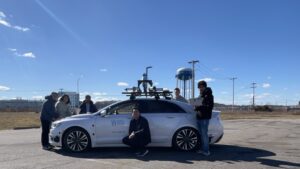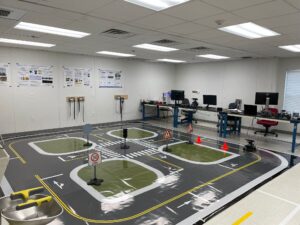CCC spoke with one of its council members, Weisong Shi about his passion for autonomous research which led him to start the Connected and Autonomous Research (CAR) Lab.
What drove you to start the CAR Lab?
In 2016, I worked on edge computing for a while and found that connected autonomous vehicles are a perfect case study of edge computing. I saw this was a huge transformative way to change the auto industry because a new era for vehicle computing was coming. Since the 1910s, for 100 years, the vehicle has been used to replace horses to ship goods and transport people. But I saw that connected vehicles, particularly autonomous driving, opened a new era for us. I saw that as a great opportunity there, and the vehicle is a mobile computing unit on wheels. I thought that software would play a significant role in the future of vehicles, so that allowed us to get computer scientists involved. In Michigan, I knew that many traditional car companies didn’t have the workforce, so that is why I formed the CAR Lab while I was at Wayne State University in Detroit, not just for research but for the future workforce and educational development, to help the whole nation transition to this new era.
How can autonomous research address issues of diversity?
In the middle of COVID-19, I was working with an autonomous shuttle company called Navya. My students and I operated our shuttle between the Detroit Medical Center and a senior living facility. During 13 weeks of operations, about 1,500 people took the shuttle, many of whom were from vulnerable populations. People living in senior homes and people with wheelchairs allowed us to understand how we can develop new technology to help these vulnerable people. Recently, we published our experience with the community in an article.
Right now, we are pushing for how to use these autonomous vehicles to help what we call financial equity. We have an Amtrak station on our STAR campus at the University of Delaware. Many people from Wilmington take the Septa train to get onto our campus. We also have over 30 companies and currently 3,600 people working here. But imagine those people, who can’t afford to drive to our campus, they take the train. So when they get to the train station, their walking usually takes 20 to 25 minutes. This is something I’m very actively seeking federal support for. Once we had that, we were operating autonomous shuttles within the campus so those people could get to where they needed to go and help them financially.

Can you give us an example of a recent successful project?
One possible area is non-emergency medical transportation (NEMT). If they call somebody, make a reservation, or even go for a physical check-up, they must wait two to three months because there aren’t many drivers available. This is where autonomous technology is the perfect example of a project since no driver is needed, and this vehicle can run 24/7. This could significantly help address that issue for most of us because we have older parents and grandparents who need to go to the doctor, and that’s very important. I’m always thinking about how to design a system to help vulnerable populations and build technology with them in mind from the beginning.
What is the process of addressing any possible challenges or errors when designing a system?
One of my PhD students is currently working on a research paper that addresses this question because, with today’s autonomous driving algorithms, I haven’t publicly seen anybody publish a paper taking into consideration people’s personal behavior behind the wheel. Our idea is that the future of autonomous design should consider that. The challenge here is how we describe personal driving behaviors. Each individual has a behavior, and if we can understand that, how can we integrate this behavior into a particular vehicle? We want to characterize the driving behavior individually so cars can drive in a way that is comfortable and safe for us. Another example is getting on the bus with a wheelchair, which can be very challenging because of the slope design. As a normal person, you may think it’s very easy, but for every one-degree increase, it may be difficult for them to move the wheels with their hands. The ramp could be too steep for them. The solution is to get a longer ramp to help them with their movement.
Where do you see the future of autonomous research/technology in 10 years?
Some people believe that the technology is ready and that it’s just a public policy issue. I have a slightly different view on that. I don’t think the technology is completely ready today. That’s the reason why our group is spending time running real deployments. If you don’t test it with human consideration in mind, then how can you design a good product? The current model is that companies just design a product and say it’s ready for end users. So in the next five to 10 years, I see a need for indoor autonomous technology for places like hospitals or assisted living homes where staff is short. On the public road, although there is progress, we will still see fewer autonomous vehicles for individual owners because of the cost. All in all, the technology will be first applied to some special operation domains, and then at the same time, we’ll be more advanced in technology and will be ready to operate on public roads in the future.
Building reliable autonomous vehicles can be challenging, but it starts with envisioning the various communities it can impact.









